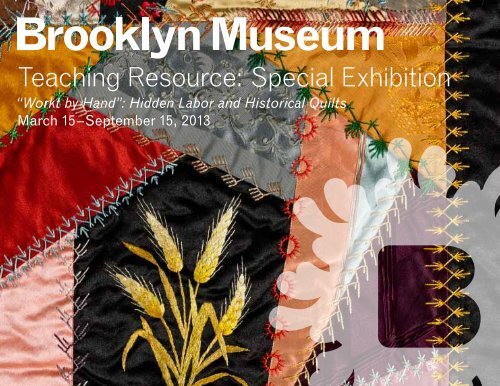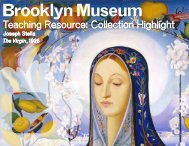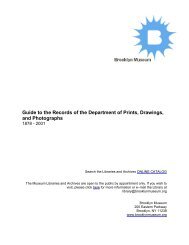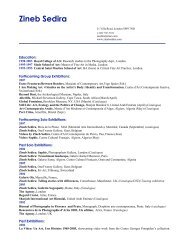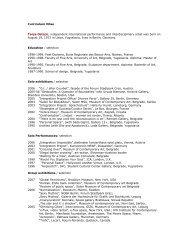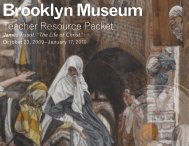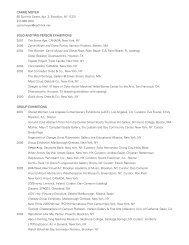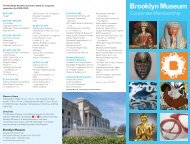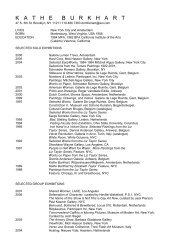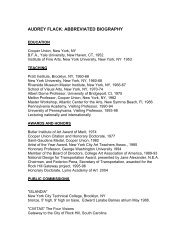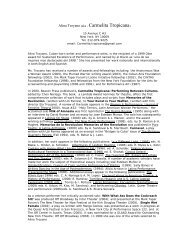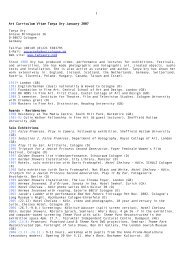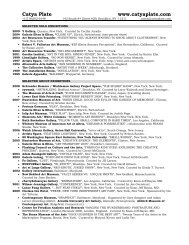"Workt by Hand": Hidden Labor and Historical Quilts
"Workt by Hand": Hidden Labor and Historical Quilts
"Workt by Hand": Hidden Labor and Historical Quilts
You also want an ePaper? Increase the reach of your titles
YUMPU automatically turns print PDFs into web optimized ePapers that Google loves.
Teaching Resource: Special Exhibition<br />
“<strong>Workt</strong> <strong>by</strong> H<strong>and</strong>”: <strong>Hidden</strong> <strong>Labor</strong> <strong>and</strong> <strong>Historical</strong> <strong>Quilts</strong><br />
March 15–September 15, 2013
Why is this exhibition in the Elizabeth A. Sackler Center for<br />
Feminist Art?<br />
The title for the exhibition helps us answer this question. “<strong>Workt</strong>” is an archaic<br />
spelling of “worked,” <strong>and</strong> the phrase “workt <strong>by</strong> h<strong>and</strong>” indicates the distinctive<br />
<strong>and</strong> personal nature of an object produced <strong>by</strong> a skilled craftsperson. “<strong>Hidden</strong><br />
labor” refers to the enormous amount of creative energy women put into their<br />
quilts, which went unrecognized <strong>by</strong> an economic system that attributed more<br />
value to men’s individual creative activities.<br />
“<strong>Workt</strong> <strong>by</strong> H<strong>and</strong>”<br />
<strong>Hidden</strong> <strong>Labor</strong> <strong>and</strong> <strong>Historical</strong> <strong>Quilts</strong><br />
Quilting has traditionally been considered a women’s medium; historically,<br />
women sewed on their own or gathered together for communal quilting bees<br />
to create collective designs. These gatherings still happen today, <strong>and</strong> provide<br />
groups with the chance not only to share their skills but to share stories of<br />
their lives. Gatherings such as quilting bees have provided the opportunity for<br />
women to leave their homes <strong>and</strong> to socialize with other women. In contexts<br />
where women were not likely to hold the status of professional artists, quilting<br />
was an opportunity for creativity <strong>and</strong> visual expression.<br />
About the Exhibition<br />
“<strong>Workt</strong> <strong>by</strong> H<strong>and</strong>”: <strong>Hidden</strong> <strong>Labor</strong> <strong>and</strong> <strong>Historical</strong> <strong>Quilts</strong> features quilt<br />
masterpieces from the Brooklyn Museum's collection that exemplify the<br />
most iconic designs <strong>and</strong> techniques from the past two centuries of quiltmaking.<br />
The exhibition examines how feminist scholarship has influenced<br />
the interpretation of historical quilts, exploring issues of anonymity,<br />
authorship, <strong>and</strong> collective production, as well as the historical choice to<br />
classify quilts under the heading of craft rather than art.<br />
The line between those categories began to blur in the mid-twentieth<br />
century, when museums started to exhibit quilts as abstract art. This shift<br />
is explored <strong>by</strong> presenting the quilts in this exhibition both vertically—as they<br />
are now frequently shown in museums <strong>and</strong> galleries—<strong>and</strong> horizontally, as<br />
they would appear on the beds for which they were often originally designed.<br />
In some communities, men have also been identified as quilters (see<br />
Resources: Men <strong>and</strong> the Art of Quiltmaking), but the female tradition is<br />
more widely recognized. In the mid-twentieth century, museums started<br />
exhibiting quilts as art, rather than artifacts. They were displayed on walls as<br />
unattributed works with minimal historical context, meant to be considered<br />
in relation to the work of the mostly male abstract artists popular at the<br />
time. Many feminists of the era spoke out to make sure that women quilters<br />
remained part of the conversation about their work.<br />
Feminist interest in quilts has led to extensive research into the lives of quilters,<br />
the diversity of quilting traditions, <strong>and</strong> the symbolic roles quilts play in accounts<br />
of the past. Just as important, feminist scholars began to examine the way<br />
categories such as fine art, craft, or historical artifact affect how society<br />
values <strong>and</strong> responds to quilts <strong>and</strong> quilt-makers. Presenting the Brooklyn<br />
Museum’s collection of quilts in the Sackler Center allows us to engage in this<br />
debate <strong>and</strong> to use historical documents, photographs, <strong>and</strong> publications to<br />
examine how people have approached <strong>and</strong> appreciated quilts over the past one<br />
hundred <strong>and</strong> fifty years.
Types of <strong>Historical</strong> <strong>Quilts</strong><br />
Album: These quilts are made up of<br />
individual squares called blocks, each<br />
with an individual design appliquéd<br />
onto it (a process in which separate<br />
pieces of fabric are stitched onto the<br />
block). Album quilts gained popularity<br />
in the mid-nineteenth century,<br />
starting in Baltimore, which was a<br />
wealthy center of fabric production<br />
after the Civil War.<br />
Bars: Bars quilts use simple patterns<br />
with rich, solid colors <strong>and</strong> detailed<br />
stitching <strong>and</strong> are typical of the Amish<br />
quilting style. These quilts were<br />
among the first to be reinterpreted<br />
as more than simply craft objects <strong>by</strong><br />
art historians who linked them to the<br />
abstract <strong>and</strong> Minimalist modern art<br />
paintings being made in the midtwentieth<br />
century.<br />
Crazy: This quilt style uses patches<br />
of fabric sewn together without<br />
a regular, repeating pattern. The<br />
term “crazy” may relate to a pottery<br />
effect called “crazing,” where<br />
irregular crackles appear across the<br />
surface of a fired piece. Examples<br />
of crazed pottery were shown at the<br />
Philadelphia Centennial Exposition in<br />
1876, which Americans visited <strong>by</strong> the<br />
millions, <strong>and</strong> may have led to the late<br />
nineteenth-century increase in the<br />
popularity of crazy quilts.<br />
Log Cabin: In a log cabin quilt, each<br />
quilt block has a central square as its<br />
focus. When the blocks are pieced<br />
together, they often form an overall<br />
pattern of contrasting light <strong>and</strong> dark<br />
areas. This style has historically been<br />
considered typically American, as the<br />
complexity of the design displays a<br />
quilter’s ingenuity <strong>and</strong> determination,<br />
both thought to be characteristics of<br />
the United States’ national pride.<br />
Medallion: A medallion quilt has a<br />
central focal point surrounded <strong>by</strong><br />
other designs. It can include many<br />
different construction techniques<br />
<strong>and</strong> many variations of the central<br />
motif, making this one of the most<br />
versatile quilt styles available.<br />
Pictorial: In a pictorial quilt, a story<br />
is told <strong>by</strong> stitching together a number<br />
of individual blocks, each including<br />
recognizable images. A famous<br />
example is the AIDS Memorial Quilt,<br />
in which each square includes both<br />
a person’s name <strong>and</strong> images that tell<br />
the viewer about that person’s life.
Star of Bethlehem: These quilts<br />
(also called star quilts) use many<br />
individual diamond-shaped pieces<br />
to form a large central star. When<br />
new technology led to new fabrics<br />
in the early nineteenth century, star<br />
quilts became a popular way to show<br />
off many different textiles in one<br />
impressive display of painstaking<br />
quilting skill.<br />
Whole-cloth: This is a quilt style<br />
that uses one large piece of fabric<br />
without patchwork or appliquéd<br />
pieces. Instead, the quilting stitches<br />
themselves provide the decoration,<br />
along with additional techniques such<br />
as trapunto, in which extra stuffing<br />
is added to make some areas of the<br />
quilt st<strong>and</strong> out even more from the<br />
background.<br />
How to Make a Quilt: The Basics<br />
A quilt is comprised of three layers: the backing, the batting, <strong>and</strong> the quilt<br />
top. The backing is the underside of the quilt <strong>and</strong> sometimes carries its own<br />
decoration, which is usually simple. The batting is the stuffing that makes up<br />
the “filling” of the quilt s<strong>and</strong>wich (a term quilters use, which provides a clear<br />
visual of how a quilt is constructed). The quilt top is the most highly finished<br />
part of the quilt, where most of the design work is done. Though this is the<br />
element people most often think of when they envision quilts, to create a quilt,<br />
you must combine all three components.<br />
Questions for Viewing<br />
Select a quilt in this exhibition or from the examples provided at the end of this<br />
Teaching Resource. Look closely at the quilt. What can you see about it that<br />
reveals the skills <strong>and</strong> choices of its maker(s)?<br />
Most quilts include patterns or repeating visual elements. Can you find any<br />
examples in this quilt? How do the pattern(s) help direct your eye to move<br />
around the entire quilt surface?<br />
When looking at quilts with recognizable imagery, such as the Pictorial Quilt<br />
(circa 1840), what images can you identify? What associations do you have<br />
with those images? How do your associations affect your ideas about this quilt?<br />
In abstract quilts such as the Bars Quilt (circa 1890), colors <strong>and</strong> patterns<br />
combine to create a design that does not contain recognizable images. How<br />
do the colors <strong>and</strong> patterns in this quilt make you feel? How might your feeling<br />
change if those colors or patterns were altered?<br />
One of the most important choices a quilter can make is what fabric to use.<br />
Think about how different a quilt made of fleece would look <strong>and</strong> feel from a<br />
quilt made of satin. Look closely at this quilt. How many different fabrics can<br />
you find? Think about how those fabrics combine with each other to form an<br />
overall design. If you could touch those different fabrics, how do you think they<br />
might feel?<br />
Activities<br />
Math/Geometry: Patterns <strong>and</strong> Tessellation<br />
Two of the key mathematical principles that quilters use to compose their<br />
designs are pattern (a decorative design that repeats) <strong>and</strong> tessellation (a<br />
combination of geometric shapes that don’t overlap <strong>and</strong> have no gaps between<br />
them). Create your own quilt design using these two concepts. Decide what<br />
shapes you want to use <strong>and</strong> cut them out of paper. Use a ruler <strong>and</strong> cut<br />
carefully to make sure they are all exactly the same size. Play around with<br />
different combinations of your shapes to make different patterns. Can you<br />
make a symmetrical design? Think about using different kinds of symmetry<br />
(rotation, reflection, etc.). An illustrated description of different kinds of<br />
symmetry can be found here: http://mathforum.org/sum95/suzanne/symsusan.html.<br />
Art Making: A Quilt of Your Own<br />
<strong>Quilts</strong> have always been connected to the idea of community. Using paper,<br />
make a quilt with your fellow students. Decide on a size for the quilt blocks.<br />
They should be square <strong>and</strong> big enough to be decorated with designs (6 x 6<br />
inches is a good size), <strong>and</strong> everyone should start with the same blank square
lock. Using other pieces of paper <strong>and</strong> glue, create a design on your paper<br />
quilt block that expresses your personality. Be creative with your paper: cut<br />
it while it is folded, combine cut pieces <strong>and</strong> torn pieces, think about making<br />
patterns. When everyone in the class has made their own quilt block, tape<br />
them all together to form a big class quilt.<br />
Social Studies: Quilting Communities<br />
Quilting is an important practice in many communities, each with their own<br />
unique traditions. Research the quilting traditions of a community of your<br />
choice (think about both past traditions <strong>and</strong> how they continue today). Share<br />
your findings in writing or in an oral presentation. Include illustrations so<br />
everyone can see examples of different quilts. (Hint: African American, Native<br />
American, <strong>and</strong> Amish communities are particularly known for their quilting.)<br />
English Language Arts: Quilt Stories<br />
<strong>Quilts</strong> go h<strong>and</strong> in h<strong>and</strong> with oral history. They might be made to commemorate<br />
a special occasion or a particular group of people, <strong>and</strong> the quilters may have<br />
shared memorable anecdotes while they worked. Ask your family members if<br />
they have any quilt stories to share. If so, interview them (with a voice recorder<br />
or a pen <strong>and</strong> paper) <strong>and</strong> record what they share. (Hint: If you need some<br />
guidance in how to collect stories from your family, you can find useful tips at<br />
http://dohistory.org/on_your_own/toolkit/oralHistory.html.) Or think about what<br />
or who might inspire you to make a quilt <strong>and</strong> record that. When everyone in<br />
your class has collected their stories, share them with each other to pass on<br />
the oral histories to a whole new group of listeners.<br />
Resources<br />
quilting.about.com/od/quiltingglossary/Quilting_Glossary.htm<br />
A glossary of terms specific to quilt styles <strong>and</strong> techniques.<br />
www.historyofquilts.com<br />
A website covering many of the historical aspects of quilts <strong>and</strong> the people who<br />
have made them over the years.<br />
www.aidsquilt.org <strong>and</strong> www.aidsquilttouch.org<br />
A website about the history of the AIDS Memorial Quilt, <strong>and</strong> an online<br />
interactive allowing users to zoom in on <strong>and</strong> examine individual squares.<br />
www.npr.org/templates/story/story.php?storyId=970364<br />
Audio of a 2003 National Public Radio story about the community of Gee’s<br />
Bend, Alabama, where African American women quilters have been creating<br />
unique designs since the early twentieth century.<br />
Cooper, Patricia. The Quilters: Women <strong>and</strong> Domestic Art, an Oral History.<br />
Lubbock: Texas Tech University Press, 1999.<br />
A compilation of interviews with <strong>and</strong> photographs of women quilters from the<br />
Southwestern United States.<br />
Cunningham, Joe. Men <strong>and</strong> the Art of Quiltmaking. Paducah, Ky.: American<br />
Quilter’s Society, 2010.<br />
A book <strong>by</strong> “Joe the Quilter” discussing the history of men’s quilting practices.<br />
Freeman, Rol<strong>and</strong> L. A Communion of the Spirits: African-American Quilters,<br />
Preservers, <strong>and</strong> Their Stories. Nashville, Tenn.: Thomas Nelson, 1996.<br />
A survey of photographs <strong>and</strong> stories of African American quilt-makers around<br />
the United States.<br />
Granick, Eve. The Amish Quilt. Intercourse, Pa.: Good Books, 1994.<br />
An authoritative, illustrated history of Amish quilting.<br />
Macdowell, Marsha L., <strong>and</strong> C. Kurt Dewhurst, eds. To Honor <strong>and</strong> Comfort:<br />
Native Quilting Traditions. Santa Fe: Museum of New Mexico Press, 1997.<br />
A collection of essays <strong>and</strong> photographs featuring many Native American <strong>and</strong><br />
Hawaiian quilting stories that accompanied an exhibition at the Smithsonian<br />
National Museum of the American Indian.
Morris, Catherine, ed. “<strong>Workt</strong> <strong>by</strong> H<strong>and</strong>”: <strong>Hidden</strong> <strong>Labor</strong> <strong>and</strong> <strong>Historical</strong> <strong>Quilts</strong>.<br />
Exh. cat. New York: Brooklyn Museum, 2013.<br />
The catalogue of the exhibition, featuring essays <strong>and</strong> interview transcripts<br />
about various aspects of quilting.<br />
Cover, pages 3, 7: Mary A. Stinson (American). Crazy Quilt, circa 1880. Silk, 81¼ x 81⅝ in. (206.4 x 207.3 cm).<br />
Brooklyn Museum, Designated Purchase Fund, 1995.87. Photo <strong>by</strong> Gavin Ashworth<br />
Page 3: Bars Quilt (detail), circa 1890, Pennsylvania. Cotton, wool, 83 x 82 in. (210.8 x 208.3 cm). Brooklyn<br />
Museum, Gift of Mr. <strong>and</strong> Mrs. H. Peter Findlay, 77.122.3. Photo <strong>by</strong> Gavin Ashworth<br />
Pages 3, 8: Baskets Quilt, circa 1860. Cotton, 74⅛ x 73⅛ in. (188.3 x 185.7 cm). Brooklyn Museum, Gift of Margaret<br />
S. Bedell, 29.1379. Photo <strong>by</strong> Gavin Ashworth<br />
Pages 3, 9: Log Cabin Quilt, circa 1890. Printed cotton, printed chintz, 76 x 76½ in. (193 x 194.3 cm). Brooklyn<br />
Museum, Gift of Alice Bauer Frankenberg, 59.151.3. Photo <strong>by</strong> Gavin Ashworth<br />
Pages 3, 10: Elizabeth Welsh (American). Medallion Quilt, circa 1830. Cotton, 110½ x 109 in. (280.7 x 267.8 cm).<br />
Brooklyn Museum, Gift of The Roebling Society, 78.36. Photo <strong>by</strong> Gavin Ashworth<br />
Pages 3, 11: Pictorial Quilt, circa 1840. Cotton, cotton thread, 67¾ x 85½ in. (172.1 x 217.2 cm). Brooklyn Museum,<br />
Gift of Mrs. Franklin Chace, 44.173.1. Photo <strong>by</strong> Gavin Ashworth<br />
Pages 4, 12: Star of Bethlehem Quilt, circa 1830. Cotton, 95 x 95½ in. (241.3 x 242.6 cm). Brooklyn Museum, Gift of<br />
Alice Bauer Frankenberg, 59.151.7. Photo <strong>by</strong> Gavin Ashworth<br />
Pages 4, 13: Betsey A. Canfield (American, born 1794). Coverlet, circa 1810. Cotton, feathers, 99 x 98 in. (251.5 x<br />
248.9 cm). Brooklyn Museum, Gift of Mary Dunderdale Bedell, Maria Dunderdale Bange, <strong>and</strong> Mrs. Forbes<br />
Dunderdale, 18.168. Photo <strong>by</strong> Gavin Ashworth<br />
This packet was written <strong>by</strong> Rachel Ropeik, Museum Educator, with assistance from<br />
Alexa Fairchild, School Programs Manager, <strong>and</strong> Catherine Morris, Curator of the<br />
Elizabeth A. Sackler Center for Feminist Art, Brooklyn Museum.<br />
“<strong>Workt</strong> <strong>by</strong> H<strong>and</strong>”: <strong>Hidden</strong> <strong>Labor</strong> <strong>and</strong> <strong>Historical</strong> <strong>Quilts</strong> is organized <strong>by</strong> Catherine Morris,<br />
Curator of the Elizabeth A. Sackler Center for Feminist Art, Brooklyn Museum.<br />
This exhibition is made possible <strong>by</strong> the Elizabeth A. Sackler Foundation.


